In cockroach, the testes are present in
3, 4, 5 abdominal segments
4, 5, 6 abdominal segments
5, 6, 7 abdominal segments
6, 7, 8 abdominal segments
Correct Answer :
B. 4, 5, 6 abdominal segments
Testes are paired, 3-4 lobed, situated dorsolaterally just below 4, 5, 6 abdominal segments.
Related Questions
The intercellular material of the given figure is solid and resists compression. Identify the figure and the label marked as A & B.
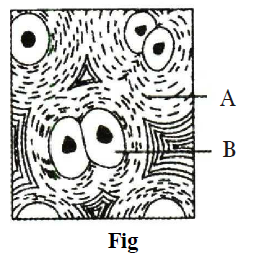
Fig - Cartilage, A - Collagen, B - Collagen
Fig - Cartilage, A - Microtubule, B - Collagen fibres
Fig - Bone, A - Chondrocyte, B - Chondroclast
Fig - Bone, A - Chondroclast, B - Osteoblast
Which of the following statement is/are correct regarding digestive system of cockroach ?
- Mouth opens into a short tubular pharynx, leading to a narrow tubular passage called oesophagus.
- Gizzard helps in grinding the food particles.
- A ring of 6-8 blind tubules called hepatic or gastric caecae is present at the junction of foregut and midgut, which secrete digestive juice.
- At the junction of midgut and hindgut is present another ring of 100-150 yellow coloured thin filamentous malphigian tubules which help in removal of excretory products from haemolymph.
Only (i)
Both (ii) and (iii)
Both (i) and (iv)
All of these
Identify the figure with its correct function Fig :. Adipose connective tissue
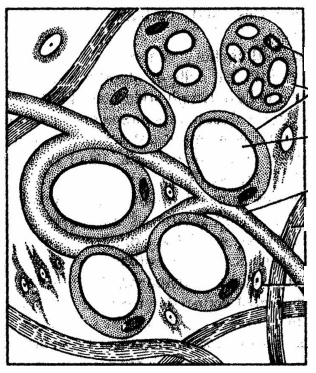
Areolar connective tissue Serves as a support framework for epithelium.
Adipose tissue Store fats and act as heat insulators.
Dense regular tissue Provide flexibility.
Dense irregular tissue Provide strength and elasticity.
The ciliated columnar epithelial cells in humans occur in
Eustachian tube and stomach lining
bronchioles and fallopian tubes
bile duct and oesophagus
fallopian tubes and urethra
Compound squamous epithelium is found in
stomach
intestine
trachea
pharynx
Consider the following statements regarding cockroach and mark the correct option.
- Head is formed by the fusion of 6-segments.
- Mouth parts are biting and chewing type.
- Crop is the part of mid gut.
Only (ii) is correct
(ii) and (iii) are correct
(i) and (ii) are correct
Only (iii) is correct
Phallic organs in cockroach are related to
male excretory system.
male reproductive system.
female excretory system.
female reproductive system.
A student was given a sample of tissue. He observes and concludes the following characters.
- The cells are composed of a single layer of tall and slender cells.
- Their nuclei are located at the base.
- Free surface may have microvilli.
- It is found in the lining of stomach and intestine
- They help in secretion and absorption.
Based on the above features identify the epithelium.
Cuboidal epithelium
Columnar Epithelium
Squamous epithelium
Glandular epithelium
The given figure shows open circulatory system of cockroach with structure marked as A, B and C. Which structure is a 13 pair of wing shaped involuntary muscles and mantain blood circulation?

A
B
C
Both A nad B
The supportive skeletal structures in the human external ears and in the nose tip are examples of
ligament
areolar tissue
bone
cartilage
In cockroach, the testes are present in
3, 4, 5 abdominal segments
4, 5, 6 abdominal segments
5, 6, 7 abdominal segments
6, 7, 8 abdominal segments
The secretions of endocrine glands are released directly
into the skin surface
into the blood stream
into a gland duct
into the brain tissue
Muscle tissue cells are contractile, which means they
are responsible for the production and secretion of enzymes.
are specialized in contraction and relaxation.
help in the movement of involuntary organs only.
all of the above
Which of the following statement is correct regarding Female reproductive system of earthworm ?
It consists of two large ovaries, lying laterally in the 6th 7th abdominal segments.
Each ovary is formed of a group of five ovarian tubules or ovarioles, containing a chain of developing ova.
A pair of spermatheca is present in the 5th segment which opens into the genital chamber.
None of the above
The given figure shows the nephridial system of earthworm and answer the question.
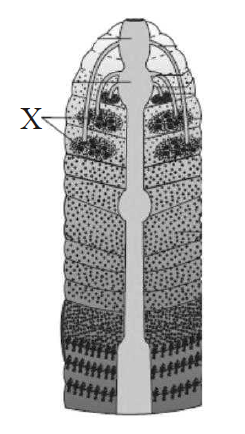
Select the option which shows the correct identification and the function of the structure marked as X.
Lateral heart. It is a blood pumping organ.
Calciferous glands. They neutralize the humic acid present in humus.
Nephridia. It regulates the volume and composition of the body fluids.
Blood glands. They produce blood cells and haemoglobin which is dissolved in blood plasma.
The only type of cell seen in a tendon is
muscle fibres
reticular cells
collagenous cells
fibroblasts
Which of the following animal's sensory system does not has eyes but does possess light and touch sensitive organs (receptor cells) to distinguish the light intensities and to feel the vibrations in the ground?
Frog
Snake
Earthworm
Cockroach
In all connective tissues, except which of the following, the cells secretes the fibres of collagen or elastin protein ?
Bone
Cartilage
Areolar connective tissue
Fluid connective tissue
Match the description given in column I with their examples given in column II and choose the correct option.
| Column I | Column II |
|---|---|
| (Description) | (Example) |
| 1. Aquatic respiratory | A. Skin organ |
| 2. Organ which acts | B. Ureter urogenital duct and opens into the cloaca |
| 3. A small median chamber | C. Cloaca that is used to pass faecal matter, urine and sperms to the exterior |
| 4. A triangular structure | D. Sinus venosus which joins the right atrium and receives blood through vena cava |
1 - A, 2 - B, 3 - C, 4 - D
1 - C, 2 - A, 3 - D, 4 - B
1 - B, 2 - A, 3 - C, 4 - D
1 - C, 2 - B, 3 - D, 4 - A
Statement 1 : Intercalated discs are important regions of cardiac muscle cells.
Statement 2 : Intercalated discs function as boosters for muscle contraction waves.
Statement-1 and statement-2 are true and statement-2 is a correct explanation for statement-1.
Statement-1 and statement-2 are true and ttatement-2 is not a correct explanation for statement-1
Statement-1 is true, and statement-2 is False
Both the statements are false.
The frog never drinks water but absorbs it through one of its respiratory organ. Identify the organ.
Skin
Lung
Buccal cavity
None of the above.
Nervous tissue cells that play several supporting roles but do not transmit impulses are called
glial cells
dendrites
nerve cells
neurons
General function of gland is to
protect the body.
control the function of epithelial tissues.
produce and secrete specialized compounds to control and maintain different body functions.
help to maintain blood pressure and nerve actions.
Which of the following statement (s) is/are correct ?
- Loose connective tissue contains fibroblasts, macrophages and mast cells.
- Adipose tissue is a type of dense connective tissue located mainly beneath the skin.
- Tendons and ligaments are examples of dense irregular connective tissue.
- Cartilage, bones and blood are various types of specialized connective tissue.
Only (i)
Both (ii) and (iv)
Both (i) and (iii)
(i), (iii) and (iv)
The blood of cockroach contains no respiratory pigment. It means that
cockroach does not respire.
respiration is anaerobic.
oxygen goes directly into tissues by diffusion.
oxygen goes directly into tissues by intracellular capillary system.
The figure given below shows the alimentary canal of cockroach with few structures labelled as 1, 2, 3 and 4. Identify the correct identification of the structure which is also called proventriculus and helps in grinding the food particles.
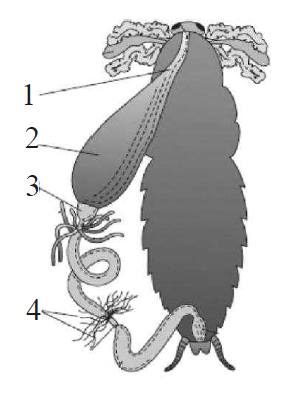
1
2
3
4
Which of the following statement(s) is/are correct regarding cockroaches ?
- The body of the cockroach is segmented and divisible into three distinct regions head, thorax and abdomen.
- Blood vascular system is of closed type.
- They are monoecious and both sexes have well developed reproductive organs.
- The development of P. americana is paurometabolus, meaning there is development through nymphal stage.
Both (i) and (ii)
Both (ii) and (iii)
Both (i) and (iv)
All of these
When cardiac muscle cells are damaged by a heart attack, they are usually replaced by
connective tissue cells
new smooth muscle cells
new cardiac muscle cells
epithelial cells
Figure given below shows reproductive system of female cockroach. The correct labellings indicated by alphabets (A, B & C) are respectively
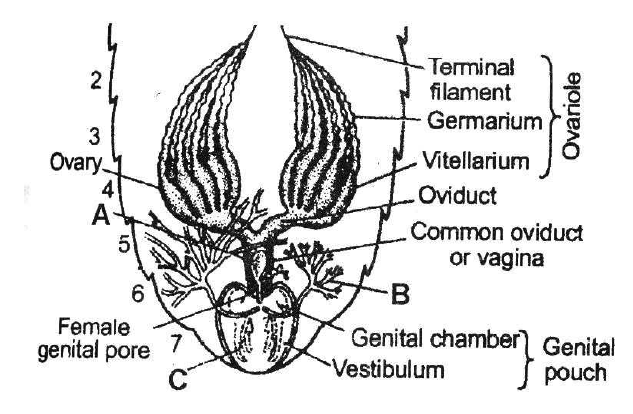
A-Spermatheca, B-Collaterial glands, C-Gonapophyses
A-Phallic gland, B-Collaterial glands, C-Gonapophyses
A-Spermatheca, B-Seminal vesicle, C-Gonapophyses
A-Spermatheca, B-Collateral glands, C-Tegmina
If the head of cockroach is cut off, it will still alive for as long as one week. It is because of
the body which is covered with a hard chitinous exoskeleton.
head which holds a bit of nervous system.
head which is of no use.
food capturing appratus which is found elsewhere.
